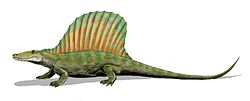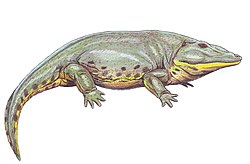Top Qs
Timeline
Chat
Perspective
Nocona Formation
Geologic formation in Texas, United States From Wikipedia, the free encyclopedia
Remove ads
The Nocona Formation is a geological formation in Texas, dating back to the Wolfcampian series (Early Permian). As part of the Texas red beds, it is one of several formations renowned for dense bonebeds of terrestrial vertebrate fossils.[1][2][3]
Remove ads
Geology
Summarize
Perspective
The Nocona Formation was named as a distinct geological unit in 1987; its fossil deposits were previously assigned to the Admiral Formation, a time-equivalent marine deposit located further southwest in Texas. The Nocona Formation is considered equivalent to most of the Admiral Formation (apart from the highest few layers), as well as the Coleman Junction Formation.[4][5] The Nocona Formation overlies the Archer City Formation and underlies the Petrolia Formation. A few sources consider the Nocona Formation to be part of the Archer City Formation,[6] but most regard it as a distinct unit.[7]
Reddish-brown mudstone is the most common rock type in the formation, though grey mudstone and other laminated fine sediments are predominant in bonebeds. 11 distinct layers of dark brown sandstone are thick and extensive enough to be mapped out on a regional scale. The formation is most well-exposed in Archer and Clay counties, extending as far northeast as the Red River which defines the Texas-Oklahoma border. It reaches its thickest extent of around 350 feet in Clay County, where individual sandstone beds can reach a thickness of 40 feet. The most southern extent of the Nocona Formation is the southwestern portion of Archer County.[4][5][8]
Bonebeds
One particularly notable bonebed is the Geraldine Bonebed in Archer County, discovered by Alfred Sherwood Romer in 1932.[1] Numerous partial and complete skeletons have been recovered from this site, including some of the best fossils of Edaphosaurus boanerges, Archeria crassidisca, Eryops megacephalus, and (to a lesser extent) Dimetrodon natalis.[2] The skeletons are generally preserved in straight, relaxed poses, with the skull aligned towards the east, southwest, or north. Both conditions are similar to modern abrupt mortality events where the animals' corpses end up in permanent bodies of water. Plant debris and charcoal are common in the bonebed as well. It is conceivable that most of the animals killed by a single catastrophe, perhaps a forest fire which polluted the air and water to kill both terrestrial and aquatic animals in the confines of a small lake or pond.[2]
Other productive Nocona Formation bonebeds in Archer County include the Briar Creek Bonebed,[1] Coprolite Bonebed (named for its concentration of shark coprolites), Loftin Bonebed, and Rattlesnake Canyon 2 Bonebed.[3] Their fossil content is more diverse than the Geraldine Bonebed, but also less well-preserved. Unlike the catastrophic scenario implied for Geraldine, these other bonebeds are assumed to be a product of gradual processes of death and decay experienced in calm pond environments.[3]
Remove ads
Paleobiota
Summarize
Perspective
Color key
|
Notes Uncertain or tentative taxa are in small text; |
Synapsids
An egg-like object was discovered by Llewellyn Price in the vicinity of Rattlesnake Canyon, and subsequently described by Romer and Price in 1939. It had a shell-like texture which was not easily comparable to nodules from the Permian of Texas, and the authors considered it to have potentially been laid by a "pelycosaur". If this identification is correct, it is the oldest amniotic egg in the fossil record.[9][1] Later investigations concluded that a distinct calcareous shell layer was not present, though the high concentration of phosphorus in the object suggests that it may still be an egg, albeit one with a softer outer membrane.[10][3]
Reptiles
Amphibians
Fish
Indeterminate palaeoniscoids are known from the Geraldine,[8] Coprolite, Loftin, and Rattlesnake Canyon 2 bonebeds.[3] Iniopterygian tooth whorls have been reported from the Rattlesnake Canyon area.[8]
Plants
Plant fossils are known from several bonebeds of the Nocona Formation, though they are subordinate to vertebrate fossils at most sites.[27][2] Insect damage has been recorded on leaves from the Coprolite Bonebed. It is uncommon (only a third as frequent as in modern plants), even when compared to only slightly younger sites such as the Taint locality in the Waggoner Ranch Formation. Despite the rarity of insect damage, the Coprolite Bonebed shows the oldest occurrence of skeletonization (removal of all but the veins), as well as galls, which are rarely found in Permian plant fossils.[28]
Remove ads
See also
References
Wikiwand - on
Seamless Wikipedia browsing. On steroids.
Remove ads



















